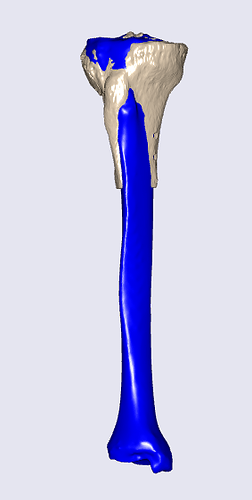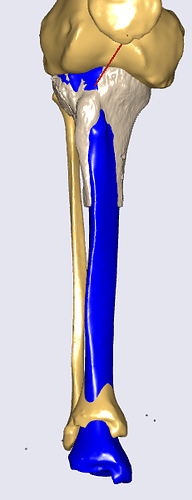Hi all,
I would like to include a personalized tibia in the StandingModelScalingDisplay in order to export muscle attachment points for an FE simulation.
In order to do this, I have an STL file of a fractured, reconstructed tibia and I woud like the AnyBody tibia to approximately match this surface.
If I perform the morphing outside the whole standing model, the result is satisfactory, but once I include the same scaling function in the Standing Model as explained in Lesson 2: Including a custom scaling function into your model — AnyBody Tutorials v7.4.0, the scaling looks different.
This is my transformation:
AnyFunTransform3DLin2 RigidTransform =
{
// Source Points (AnyBody Tibia Landmarks)
Points0 = 0.001*{
{38.669,271.221,8.968}, // Tuberositas tibiae
{-1.995,324.449,44.601}, // Condylus lateralis
{-1.156,322.809,-44.791}, // Condylus medialis
{-3.8,341.661,3.635}, // Tuberculus lateralis
{-1.894,339.854,-10.245}, // Tuberculus medialis
{-26.881,318.974,27.329}, // Condylus posterolateralis
{-28.374,323.039,-16.314}, // Condylus posteromedialis
{-5.435,251.746,-3.913}, // Posterior Point
{-7.535,289.903,1.719} // Posterior Curvature Point
});
// Target Points (Custom Tibia Landmarks)
Points1 = 0.001*{
{-9.169,-28.448,-33.545}, // Tuberositas tibiae
{-31.588,-5.353,-4.502}, // Condylus lateralis
{35.381,5.87,-5.12}, // Condylus medialis
{0.027,3.647,8.050}, // Tuberculus lateralis
{6.581,4.973,6.739}, // Tuberculus medialis
{-10.321,19.616,-9.286}, // Condylus posterolateralis
{11.89,25.755,-11.103}, // Condylus posteromedialis
{0.507,6.124,-53.613}, // Posterior Point
{-1.743,8.486,-35.638} // Posterior Curvature Point
};
Mode = VTK_LANDMARK_SIMILARITY;
};
AnyFunTransform3DLin2 ReverseTransform =
{
Points0 = .RigidTransform.Points1;
Points1 = .RigidTransform.Points0;
Mode = VTK_LANDMARK_RIGIDBODY;
};
AnyFunTransform3D FinalTransform = {
PreTransforms = {&.RigidTransform, &.ReverseTransform};
};
I then draw the two surfaces as follows:
AnyDrawSurf AnyTibia =
{
FileName = "TibiaRight_AnyBody_localCsys.anysurf3";
AnyFunTransform3D &ref = .FinalTransform;
};
AnyDrawSurf CustomTibia =
{
FileName = "P4.anysurf3";
AnyFunTransform3D &ref = .ReverseTransform;
};
The result looks like this (which is satisfactory for my scope):
I then proceed to include this function in the Standing Model (here I'm omitting the lines with the mirrored function for the contralateral side for shortness):
HumanModel.Scaling.GeometricalScaling = {
#define CUSTOM_SCALING_Right_Shank
Right.Shank = {
#include "TibiaScalingFunction.any"
AnyFunTransform3D &ScaleFunction = TibiaScalingFunctions.FinalTransform;
};
};
whereby TibiaScalingFunction.any looks like this:
AnyFolder TibiaScalingFunctions = {
AnyFunTransform3D FinalTransform = {
PreTransforms = {&.RigidTransform, &.ReverseTransform};
};
AnyFunTransform3DLin2 RigidTransform =
{
// Source Points (AnyBody Tibia Landmarks)
Points0 = ..TSeg2ScaleFrame(0.001*{
{38.669,271.221,8.968}, // Tuberositas tibiae
{-1.995,324.449,44.601}, // Condylus lateralis
{-1.156,322.809,-44.791}, // Condylus medialis
{-3.8,341.661,3.635}, // Tuberculus lateralis
{-1.894,339.854,-10.245}, // Tuberculus medialis
{-26.881,318.974,27.329}, // Condylus posterolateralis
{-28.374,323.039,-16.314}, // Condylus posteromedialis
{-5.435,251.746,-3.913}, // Posterior Point
{-7.535,289.903,1.719} // Posterior Curvature Point
});
// Target Points (Custom Tibia Landmarks)
Points1 = 0.001*{
{-9.169,-28.448,-33.545}, // Tuberositas tibiae
{-31.588,-5.353,-4.502}, // Condylus lateralis
{35.381,5.87,-5.12}, // Condylus medialis
{0.027,3.647,8.050}, // Tuberculus lateralis
{6.581,4.973,6.739}, // Tuberculus medialis
{-10.321,19.616,-9.286}, // Condylus posterolateralis
{11.89,25.755,-11.103}, // Condylus posteromedialis
{0.507,6.124,-53.613}, // Posterior Point
{-1.743,8.486,-35.638} // Posterior Curvature Point
};
Mode = VTK_LANDMARK_SIMILARITY;
};
AnyFunTransform3DLin2 ReverseTransform =
{
Points0 = .RigidTransform.Points1;
Points1 = .RigidTransform.Points0;
Mode = VTK_LANDMARK_RIGIDBODY;
};
};
However, the result I get is thinner and shorter compared to previous one, as can be seen here:
What am I missing? Are there other scaling functions that are being applied to my tibia except for my desired transformation?
Thank you in advance for your help.
Best regards,
Marco

